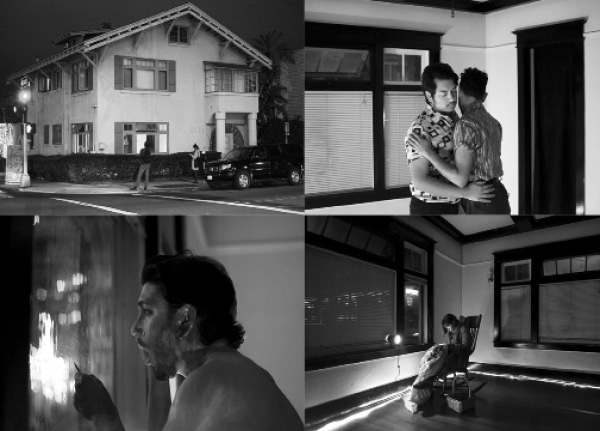
PARLOR
first performed on December 20, 2017
345 Laurel Street, San Diego, CA
performed four times over four evenings in 2017
ASSEMBLAGE
(ALAN LUNA / JESZICA MCPEAK)
San Diego, CA / Tijuana, Mexico
179274785a179274785s179274785s179274785e179274785m179274785b179274785l179274785a179274785g179274785e179274785a179274785r179274785t179274785e179274785@179274785g179274785m179274785a179274785i179274785l179274785.179274785c179274785o179274785m
assemblagearte.com
PARLOR
ASSEMBLAGE
“Parlor” is a performative exploration of queerness and the home that occured over the course of four evenings in the winter of 2017. On the corner of Laurel St. and 4th Ave, in San Diego, the artists performed in what was once the parlor of a house built in 1912.
Each evening was the site of a performance. In the parlor, bathed in soft pink light, the gestures were as follows. Dressed in mid-century attire, Alan Luna slow-danced with Viktor de la Fuente for one hour to the 1961 song “Will You Still Love Me Tomorrow?” Edin Solis performed the act of subverting gender through dress-up, finalizing their gesture by exiting the parlor into the night. Jeszica McPeak sat in a rocking chair by the windowsill and spoke to passersby as she embroidered a poem onto a quilt.
These gestures, performed before large bay windows, exist in a liminal space between the private and the public realm. Though in the home, the performers were exposed to the peering eyes of passersby outside. Stopping to observe the actions within the parlor at their leisure, their gaze and voyeuristic participation perpetuate the power dynamics between the public and the queer.
The site of “Parlor” holds a subjectivity in relation to a local queer historical site. Positioned near the southwest end of Balboa Park is an unassuming stretch of sidewalk and bush. It is commonly referred to as the Fruit Loop or Queen’s Circle, a designation lovingly bestowed in acknowledgement of its popularity as a gay cruising spot. However, this history is mostly invisible to the public who walk these neighborhoods. Yet over the course of a century, the house has stood witness to both the oppression and liberation of San Diego’s queer communities.
As a collection, these gestures reveal through evocation a reconstruction of a speculative, queer-centric past. Rooted in collective experiences of gender, race, and privacy, these gestures reclaim a queer history lost to silence. Reflecting on an America before the Gay Liberation movement, “Parlor” explores the tensions between a queer life relegated to the interior sanctuary of the home, and the intrusions of those who would legislate and control the lives of queer peoples.
“Parlor” is as much an elegy as it is a warning.